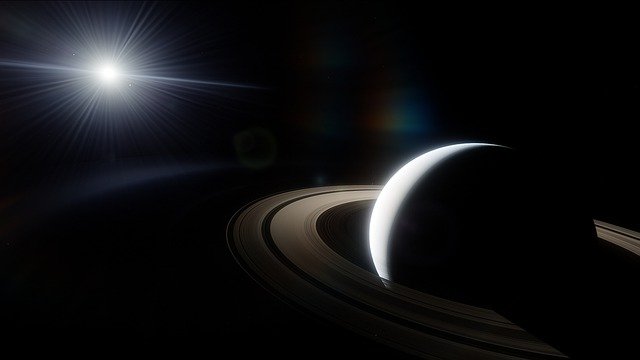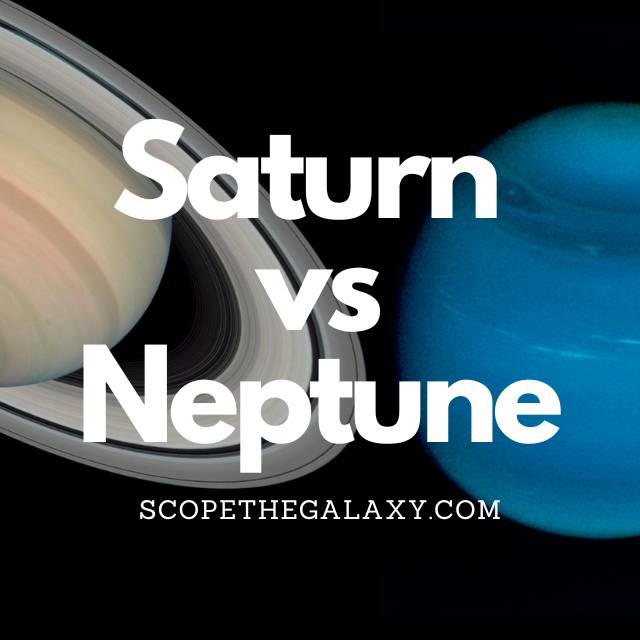*This post may contain affiliate links. This means we may make a commission if you purchase an item using one of our links*
The main differences between Saturn and Neptune is that Saturn is the second largest planet whilst Neptune ranks as 4th in the solar system, Saturn is pale yellow in color whilst Neptune is deep blue, Saturn is a gas giant whilst Neptune would be regarded as an ice giant and Saturn has 82 moons orbiting it whereas, Neptune has 14.
There are also a fair few similarities between the two along with a number of other differences so, continue reading for a more detailed breakdown of these elements.
What Is The Planet Saturn?
Table of Contents

Saturn is the second largest planet in our solar system, that has a multitude of rings surrounding its gaseous exterior. It’s also the 6th farthest planet from the Sun.
As Saturn falls under the gas giant moniker, the planet is mostly made up of gases. However, Saturn’s composition is a little different from Jupiter’s where its atmosphere is mixture of hydrogen and ices containing elements of Ammonia.
It’s core on the other hand is comprised of a dense core of nickel and iron, which is then surrounded by rocks compressed so strongly that it can tends to reach scorching hot temperatures of 11,700+ degrees celsius.
On the other hand, It’s gaseous atmosphere is far cooler. The exterior generally sits in the extreme sub zero range where Saturn’s temperatures is -138 degrees celsius.
This is generally constant throughout the yellow ringed giants day to day. In fact it’s much colder than even the coldest place on Earth, which would be Eastern Antarctic Plateau, Antarctica that hits -94 degrees Celsius, which is more than 40 degrees celsius warmer.
Being so large, Saturn’s gravitational pull is obviously strong. That’s why over it’s 4.5 billion years of existence, beyond its rings this yellow gas giant has managed to accumulate 82 different moons along with other smaller interstellar debris that now orbit it.
In fact it’s largest moon Titan is literally bigger than one of the 8 planets orbiting the Sun, Mercury.
Saturn also orbits the Sun but, as the 6th farthest planet from it, it does mean a singular orbit will take it 29.4 Earth years to complete. In comparison to its axial orbit which only takes 10.7 hours, this is exponentially longer.
What Is The Planet Neptune?

Neptune is the 8th farthest planet from the Sun and ranks among the bigger planets in our solar system. As the 8th farthest planet from the Sun, it does take Neptune a very long time to complete 1 orbital cycle around the Sun.
This takes 165 years to complete which is far longer than the 16 hours needed to complete 1 full day/full spin around the axis.
In regards to its composition, Neptune is mostly made up of a thick swath of water closer to the center, methane, ammonia, hydrogen and helium molded around its Earth sized core.
As a result of the excess amount of methane and the inclusion of another undiscovered element within the atmosphere, Neptune’s color is a far deeper blue than the likes of Uranus, which also has a methane based atmosphere.
The planet is 49,244km in diameter, making it roughly 4 times Earth’s diameter, and would allow around 57 Earth sized planets to fit inside it. This also makes Neptune the 4th largest planet in our solar system.
Neptune is very cold, which is mostly down to its distance from the Sun, where its atmospheric temperature sits between -220 to -230 degrees Celsius. Its core is far hotter coming in at 5,100 degrees Celsius and is the very likely cause for the liquid water present within the planet.
Subsequently, the erratic temperature and gaseous composition of Neptune, is what constitute towards its turbulent behavior.
In fact Neptune has the fastest winds in our solar system, producing some that eclipse speeds of 2,000km per hour. The fastest winds on Earth would only be a fifth of these speeds at most.
At this moment in time we have discovered 14 moons orbiting Neptune and have also observed 5 thinner rings surrounding the ice giant.
Similarities Between Saturn And Neptune
Saturn and Neptune have a fair few similarities between themselves, which would include the following:
- Both planets are generally composed of hydrogen and helium, among other gases.
- Both planets are orbiting the Sun.
- Both have a hotter central core.
- Both have multiple moons.
- Both have rings surrounding them them.
- Both are roughly the same age where they are estimated to be around 4.5 billion years old.
Differences Between Saturn And Neptune
In regards to the differences, it includes the below:
- One of Saturn’s most spectacular features would be its ring system that can even be observed through a telescope, whereas Neptune’s rings are much harder to spot. Saturn has 7 rings and Neptune has 5.
- Saturn is pale yellow in color whereas Neptune is deep blue.
- Neptune is colder with an atmospheric temperature around -220 degrees celsius whereas Saturn’s average temperature is -138 degrees celsius. Neptune’s core is only 5,100 degrees celsius whereas Saturn has a core temperature of 35,700 degrees celsius.
- Neptune is the smaller planet of the two with a diameter of 49,244km whereas Saturn is 116,460km. This means that 57 Earths can fit inside Neptune whilst Saturn would allow 764 Earths to fit inside.
- Saturn can complete a spin cycle around its axis in 10 hours but Neptune will take 16 hours to complete its rotation.
- Saturn orbits the Sun once every 12 years whilst Neptune takes 165 years to orbit the Sun.
- Saturn has 82 moons and Neptune only has 14.
- Neptune is more dense than Saturn due to its lower levels of hydrogen in its overall composition.
- Saturn has a stronger magnetic field at 0.21 gauss in comparison to Neptune’s 0.13 gauss magnetic field strength.
- Neptune has a faster wind speeds within its atmosphere of around 2,000 kmph in comparison to Saturn’s speeds of 1,800 kmph.
Summary
Neptune is an ice giant whilst Saturn falls under the gas giant moniker. Saturn and Neptune both have some of the most erratic winds in our solar system and are freezing cold in general.
However, there are significant differences between both entities whether it be the size, the differences in the number of moons surrounding them and of course the time it takes for each to complete a complete cycle around the Sun.

